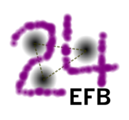Speaker
Description
Nuclear clustering is of great interest to the nuclear physics community as it allows complicated systems of many nucleons to be reduced to a few-body system, enabling the modelling of nuclei beyond where a traditional description of a nucleus would prove computationally challenging, as well as providing a good test of theoretical models. An experiment utilising the $^{12}$C($^{7}$Li, $p$)$^{18}$O* reaction was performed at Maier-Leibnitz Laboratory (MLL) in Munich by von Oertzen et al. [1] which discovered 30 new states in $^{18}$O. Using these in conjunction with previously determined states, rotational bands were proposed. Some of these bands were suggested to have cluster structures previously suggested by both theoretical and experimental work, such as $^{14}$C ⨁ $α$ and $^{12}$C ⨁ 2$n$ ⨁ $α$ [2-5]. In order to determine the validity of these assertions an experiment was performed, again at MLL with the $^{12}$C($^{7}$Li, $p$)$^{18}$O* reaction. This time, the Q3D magnetic spectrograph was used in conjunction with the Birmingham DSSD array to enable the high-resolution reconstruction of decay fragments from $^{18}$O* to determine absolute branching ratios of each high-energy excited state. The study also enabled a comparison of their α reduced widths to the Wigner limit to ascertain both the tendency towards α-clustering and consistency across the proposed rotational bands. This presentation will detail the final results of the analysis.
[1] W. von Oertzen et al. Eur. Phys. J. A, 43:1733, 2010.
[2] N. Curtis et al. Phys. Rev. C, 66:024315:110, 2002.
[3] H.T. Fortune. Phys. Rev. C, 18:1053, 1978.
[4] K.P. Artemov. Sov. J. Nucl. Phys., 37:805, 1983.
[5] G.L. Morgan. Nucl. Phys. A, 148:480, 1970.

